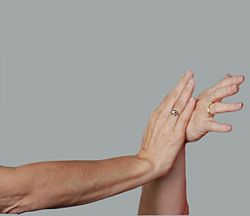
Hand strength
Encyclopedia

Hand
A hand is a prehensile, multi-fingered extremity located at the end of an arm or forelimb of primates such as humans, chimpanzees, monkeys, and lemurs...
that involves loss of muscle
Muscle
Muscle is a contractile tissue of animals and is derived from the mesodermal layer of embryonic germ cells. Muscle cells contain contractile filaments that move past each other and change the size of the cell. They are classified as skeletal, cardiac, or smooth muscles. Their function is to...
strength. Examples of these pathologies are carpal tunnel syndrome
Carpal tunnel syndrome
Carpal Tunnel Syndrome is an entrapment idiopathic median neuropathy, causing paresthesia, pain, and other symptoms in the distribution of the median nerve due to its compression at the wrist in the carpal tunnel. The pathophysiology is not completely understood but can be considered compression...
, nerve injury
Nerve injury
Nerve injury is injury to nervous tissue. There is no single classification system that can describe all the many variations of nerve injury. Most systems attempt to correlate the degree of injury with symptoms, pathology and prognosis...
, tendon
Tendon
A tendon is a tough band of fibrous connective tissue that usually connects muscle to bone and is capable of withstanding tension. Tendons are similar to ligaments and fasciae as they are all made of collagen except that ligaments join one bone to another bone, and fasciae connect muscles to other...
injuries of the hand, and neuromuscular disorders.
Hand strength testing is frequently used for clinical decision-making and outcome evaluation in evidence based medicine. It is used to diagnose
Medical diagnosis
Medical diagnosis refers both to the process of attempting to determine or identify a possible disease or disorder , and to the opinion reached by this process...
diseases, to evaluate and compare treatments, to document progression of muscle strength, and to provide feedback during the rehabilitation
Physical therapy
Physical therapy , often abbreviated PT, is a health care profession. Physical therapy is concerned with identifying and maximizing quality of life and movement potential within the spheres of promotion, prevention, diagnosis, treatment/intervention,and rehabilitation...
process. In addition, strength testing is often used in areas such as sports medicine
Sports medicine
Sports medicine is a branch of medicine that deals with physical fitness, treatment and prevention of injuries related to sports and exercise...
and ergonomics
Ergonomics
Ergonomics is the study of designing equipment and devices that fit the human body, its movements, and its cognitive abilities.The International Ergonomics Association defines ergonomics as follows:...
.
In general, hand strength measurements can be divided into manual muscle testing and dynamometry.
Manual muscle strength testing of the hand muscles
In clinical practice, hand muscles are most often evaluated using manual muscle strength testing using the Medical Research CouncilMedical Research Council (UK)
The Medical Research Council is a publicly-funded agency responsible for co-ordinating and funding medical research in the United Kingdom. It is one of seven Research Councils in the UK and is answerable to, although politically independent from, the Department for Business, Innovation and Skills...
(MRC) Scale. In this scale, muscle strength is graded on a scale from 0 to 5. For evaluating the strength of the intrinsic hand muscles, a small modification to the standard MRC grading has been made so that grade 3 indicates ‘full active range of motion’ as compared to ‘movement against gravity’:
Modified Medical Research Council Scale for measuring hand muscles
Grade 5: full active range of motion & Normal muscle resistanceGrade 4: full active range of motion & Reduced muscle resistance
Grade 3: full active range of motion & No muscle resistance
Grade 2: Reduced active range of motion & No muscle resistance
Grade 1: No active range of motion & Palpable muscle contraction only
Grade 0: No active range of motion & No palpable muscle contraction
Manual muscle testing, however, has a number of limitations. One limitation is that the MRC scale is an ordinal scale with disproportional distances between grades. Another limitation of the MRC scale is that the scoring depends on the judgment of the examiner. Finally, with the 6-point ordinal MRC scale, it is difficult to identify relatively small but clinically relevant changes in muscle strength.
Grip and pinch dynamometry
To create more quantitative assessments of hand muscle strength, dynamometers have been developed. These dynamometerDynamometer
A dynamometer or "dyno" for short, is a device for measuring force, moment of force , or power. For example, the power produced by an engine, motor or other rotating prime mover can be calculated by simultaneously measuring torque and rotational speed .A dynamometer can also be used to determine...
measurements are more sensitive to change compared to manual muscle testing and render outcome on a continuous scale.
In clinical evaluation and research studies on patients with hand problems, muscle strength measurements are usually based on grip strength
Grip strength
Grip strength is the force applied by the hand to pull on or suspend from objects and is a specific part of hand strength. Optimum-sized objects permit the hand to wrap around a cylindrical shape with a diameter from one to three inches. Stair rails are an example of where shape and diameter are...
and pinch strength dynamometry. The most commonly used grip and pinch dynamometers are the Jamar dynamometers and similar devices by other manufacturers. In several patients groups, these measurements have a good reliability and validity. In addition, grip- and pinch strength are functionally relevant to measure the combined action of a large number of intrinsic and extrinsic hand muscles as well as the combined action of a number of different joints. By comparing outcome with normative data, the amount of muscle strength loss can be determined.

